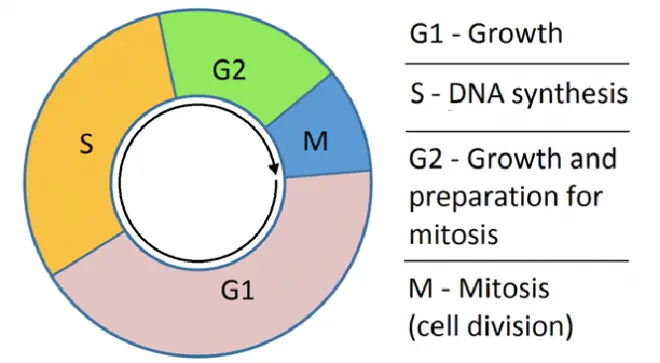基础生物实验 16 - 实验六理论简介:Mitosis 有丝分裂

本期内容是有丝分裂的基础理论部分,实验手册与实验模拟请看后两期。本部分内容来自 University of California, Berkeley - UC Berkeley Extension, 虚拟实验的内容来自 Labster. 本部分内容均不会标记为为原创,但由于是UP主购买的课程,因此不接受非授权的转载,谢谢您的理解。
每一个生物基础实验均会分为三部分:第一部分为实验的生物理论;第二部分为实验的指导手册;第三部分为 Labster 的虚拟实验模拟。第一部分的基本信息由 Ying Liu, Ph.D. 提供,第二部分的实验手册来自 Labster, 第三部分的实验模拟过程由UP主操作。
L6 - Mitosis

Why Do Cells Divide?

- Unicellular organisMs divide to reproduce;
- Multicellular organisMs divide to allow:
Development from a fertilized egg;
Growth;
Repair.
Cell Cycle
The sequence of events that a cell goes through from its origin (birth) to its own division into two daughter cells is called the cell cycle.

Interphase
- Interphase: the period between cell divisions;
- Interphase is divided into G1 (gap 1), S phase, and G2 (gap 2);
- A cell grows in size during G1 and G2 (organelles and ribosome numbers increase, new proteins synthesized).

Interphase accounts for most of the time in a cell cycle;
For a cell that divides every 24 hours, >20 hours are spent in interphase;
DNA synthesis (replication) happens in S phase.

Duration of Cell Cycle


Cell Division
- Mitosis: division of the nucleus;
- Mitosis is divided into prophase, metaphase, anaphase and telophase;
- Cytokinesis: division of the cytoplasM.

Control of Cell Cycle
- Checkpoints: can delay the cell cycle until certain conditions are met;
- There are 3 major checkpoints;
- G1/S: check for DNA damage; if passed, the cell is committed to divide.
- If DNA damage is detected:
DNA repair mechanisM;
Apoptosis: programmed cell death.
- G2/M: verifies if DNA replication is complete
- Metaphase: verifies spindle assembly and chromosome attachment
Chromatin and Chromosome
- Interphase DNA is organized into loose structures called chromatin; during mitosis, chromatin condenses to form chromosomes;
- After DNA replication, the two copies stay attached at a region called the centromere, each copy is called a chromatid.

Chromosomes
- Replication origin: multiple, origin of DNA replication, spread bi-directionally;
- Centromere: site for mitotic spindle attachment, also holds the duplicated chromosome together before cell division;
- Telomeres: special caps on each end; help in the replication of chromosome ends; also help protect chromosome ends.


Chromatin and Chromosome

Chromosomes
- Every species has characteristic numbers;
- Karyotype.

Karyotyping
- Collect tissue sample (WBCs) and culture;
- Add chemical to stimulate mitosis;
- Add chemical to stop mitosis in metaphase;
- Stain sample, take photo and arrange chromosomes.

Ploidy
- Ploidy refers to the number of ‘sets’ of genetic material;
- Humans are diploids;
- Xenopus (frogs) are tetraploids.

Mitotic Spindle and Centrioles
- Mitotic spindle and centrioles are made of microtubules;
- Both are involved in chromosome segregation.

Duplication of Centrioles
- Centrosome (and centrioles) is also duplicated in S phase;
- In animal cells, centrosomes are microtubule organizing centers;
- Plant cells do not have centrosomes.


Phases





Mitosis in Animal vs. Plant Cells

Cell Cycle Control System
- Progression through the cell cycle depends on cyclin-dependent protein kinases (Cdks);
- Cdks are regulated by cyclins, whose concentrations vary in a cyclical fashion during cell cycle;
- Once activated, cyclin-Cdk complex phosphorylates key proteins to initiate particular steps in cell cycle.


Oncogenes
- Proto-oncogenes: normal genes that promote cell cycle; when mutated, become oncogenes;
- Oncogenes act in a dominant manner: a gain-of-function mutations in a single copy of the proto-oncogene can drive a cell toward cancer;
- Examples of proto-oncogenes include: Ras, ERK (MAP Kinase), EGF receptor, and transcription factor myc.

Tumor Suppressors
- Tumor suppressors: genes that suppress tumor formation; negative regulators of cell cycle;
- Mutations in the p53 gene (involved in DNA damage repair) are found in about half of all human cancers.

- Loss-of-function mutations in tumor suppressor genes act in a recessive manner: the function of both copies of the gene must be lost to drive a cell toward cancer;
- Examples of tumor suppressors include Rb, p53 and p27.

Genetic Basis for Cancer
- Proto-oncogenes (gas pedal): products promote the cell cycle and prevent cell death (apoptosis);
- Tumor suppressor genes (brake): products inhibit the cell cycle and promote apoptosis.

Cancer: Accumulation of Mutations
- Cancer: a group of > 100 diseases that start with uncontrolled cell division;
- Usually takes a few mutations to form benign tumors, and then malignant tumors after metastasis.
Cancer Drug
- Paclitaxel: a compound extracted from yew tree;
- Prevents microtubule depolymerization, inhibits mitosis;
- Used in chemotherapy for treating cancers.

本期内容到此结束,感谢阅读!下一期为实验手册 & 下下期将进行 Labster 实验!

